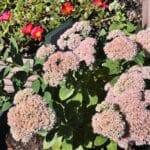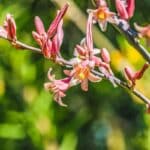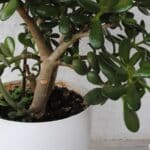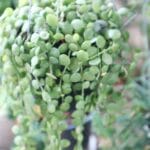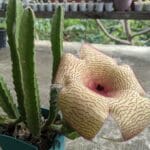Dischidia is a genus of epiphytic succulents with over 80 different unique species. In the wild, these plants are known to grow in tropical areas of the globe, in countries like India, the Philippines, New Guinea, and even Australia.
An epiphyte is a plant that grows on the surface of another object, such as on a rock or the branches of a tree. Because they do not grow in soil and put down ‘roots’ in the traditional sense of the word, epiphytes receive their nutrients from the moisture in the air, the rain, and debris that accumulates in and around them from wind.
Their unique and exotic look, and easy-to-grow reputation have now helped them become commonly grown houseplants. If you have been looking for a no-fuss houseplant to grow or gift, then consider choosing a Dischidia plant. Below you will find all the helpful information you need to grow and care for one.
Plant Facts
The genus name Dischidia was first coined by botanist Robert Brown in 1810. It comes from the Greek word “dischides”, which translates to “parted or cleated crowns”, and is a homage to the plant’s appearance.
| Scientific name | Dischidia |
| Common names | Shingle plant |
| Family | Apocynaceae |
| Plant Type | Succulent Houseplant |
| Height and Width | 12 feet wide and tall (varies depending on species) |
| Origin | China, India, Indo-China |
| Flower colors | Purple, red, etc |
| Foliage color | Gray-green |
| Sun Exposure | Indirect sunlight |
| Soil Type & pH | Use an epiphyte medium (soilless) |
| Special features | Epiphytic houseplant |
How to Grow Dischidia Plant
These plants can be conveniently grown in containers as a houseplant. Due to their flowing foliage, we particularly enjoy growing these plants in hanging containers in order to allow the foliage to spill out and hang elegantly.
These houseplants can also be grown outdoors. They do fine during the warmer parts of the year, however, depending on the type of winter in your geographic location, they may require extra shelter or be brought indoors.
If you do decide to grow them outdoors, just make sure to plant them in the shelter of other, taller plants, as they do not do well in intense and direct sunlight.
Some varieties are considered to be climbers. Support Climbing Dischidia species can be cultivated by wrapping their stems around the hangers of their hanging pots, thin branches, or a moisture-retentive, rough, and porous surface, such as tree bark medium. These can be pruned to keep the plant from developing in undesirable locations.
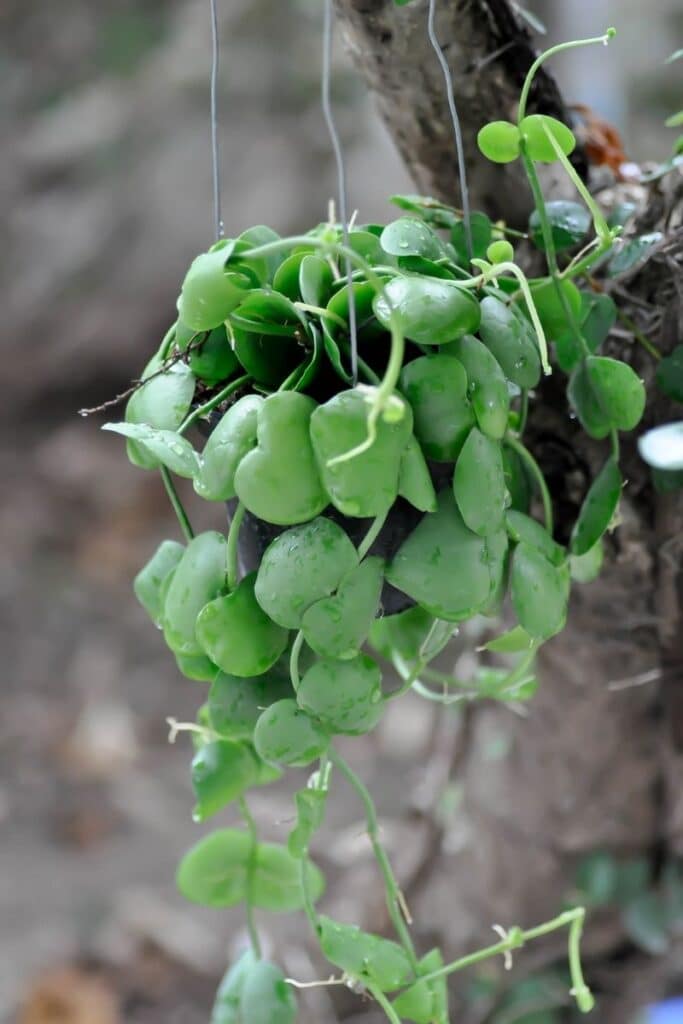
Propagation dischidia
These plants can easily be propagated from stem cuttings. Propagating from cuttings is the most reliable method, and helps to guarantee that the new plant grows with the same characteristics you love about the parent plant.
We recommend taking cuttings during the spring or summer months. Using a pair of clean scissors or pruning shears, cut below a leaf node of one of the healthiest, most established stems.
Place the cutting in water and give it time to develop new roots. This may take up to 30 days.
Remove the cutting from the water, and plant it into a new container filled with any basic cactus or succulent mixture. You may also consider mounting your cutting onto a sphagnum moss ball.
Place the freshly propagated specimens in a location where it can receive indirect sunlight, and care for it like normal.
This cute indoor plant can also be grown from seed. However, this process takes the most time by far. Plus, you cannot reliably determine how the new plant will grow and perform. Interestingly enough, the seeds have small hairs on them that help them get transported by the wind.
Climbing Dischidia species can be cultivated by wrapping their stems around the hangers of their hanging pots, thin branches, or a moisture-retentive, rough, and porous surface, such as tree bark.
Soil
Because these plants are epiphytic plants, they should not be grown in a soil-based growing medium. Instead, they should be planted in a medium that is ideal for epiphytes.
Standard store bought orchid potting mix is a good choice. However, you may also consider using shredded bark or coconut husk as a substrate. It is also possible to not use any ‘soil’ at all, and instead, mount your Dischidia plant to a sphagnum moss ball.
Pruning
These plants do not require intensive and regular pruning maintenance. However, it’s good to keep an eye out for and remove any yellowing or dying foliage. If you want to control the shape or size of your Dischidia plant, you may consider pruning once a year.
When pruning, remember to always use clean tools to avoid spreading bacterial or fungal diseases. Using a sharp tool for pruning is best because it provides the best incision, and helps avoid shocking and damaging the plant unnecessarily.
Repotting and Transplanting
Over time, your plant may begin to outgrow its container and become root-bound. When a plant is rootbound, you may begin to observe roots growing out of the drainage holes. To keep up with the growth of your Dischidia plant, you may consider repotting every 2 to 3 years. When repotting, make sure to select a container with adequate drainage.
Transplant shock is a condition that may develop if the repotting process becomes too stressful. To avoid transplant shock, we recommend you disturb the roots as little as possible. Water your plant before taking it out of its container because moist roots travel better and are less easily. Also, water your plant thoroughly after it has been transplanted into its new home.
If you have taken a cutting for propagation, it’s best to wait to transplant your new Dischidia during the early springtime.
Dissidia Care Guide
Dischidia plant care is simple if a few growing principles are followed.
The specific care you provide your plant with depends on the variety of Dischidia you have chosen to grow. However, there are some common themes no matter the Dischidia species. In general, when raising Dischidias, it’s all about mimicking their natural environment.
For these plants, it’s all about a balance between adequate moisture in the soil or growing substrate, proper lighting and good humidity. Depending on where you live, the ideal conditions may come naturally. However, in colder and dryer locations, it may take a little extra work to make sure your plants are happy and comfortable.
Water
These plants have an average water consumption. Most of the time, they are happy to be watered once a week. During the hotter months of the year, you may need to water more if the soil seems to dry out faster. On the other hand, during the winter months, your Dischidia plant may require less watering.
Avoid over watering. Oversaturation can result in root rot which can result in your precious plant dying. To avoid overwatering, check the moisture level of the planting medium with your finger. If the soil feels dry, go ahead and water. But if it still feels moist, wait.
Sunlight
Dischidia plants are native to forest-like areas where they grow amongst other tall trees and plants. For that reason, most varieties like to be grown in medium to bright indirect light.
Avoid letting your Dischidia plant be exposed to direct sunlight. Too much direct bright light can scorch the delicate and tender foliage and damage the plant.
When it comes to selecting the ideal location around the house, we recommend a southeast or west-facing window. This location should also be well-ventilated. Proper ventilation is important for preventing plant disease, and inviting pests. It is important to note, however, that good ventilation does not mean cold drafts.
Temperature and Humidity
Dischidia plants prefer warmer, tropical weather. It’s best to avoid letting your plant be exposed to cold drafts and freezing weather. If you are growing your plant indoors, this should be no problem. The ideal temperature spectrum for your plants is between 50 and 85 degrees Fahrenheit.
Because they are epiphytic, Dischidia plants also get vital moisture from the air around them. That is why Dischidia plants also like humidity. To increase the humidity level for your plant, we recommend you spray them with water.
You may also consider running a humidifier once or twice a day if your growing environment is particularly dry. When the weather is hot and humid, use a fan to create good air circulation.
Another good way to increase the humidity around your plants is to place them in a DIY humidifying tray. Simply fill a shallow tray (big enough to accommodate your Dischdia’s container), with water and pebbles. Over time, the water will evaporate and increase the humidity.
Fertilizer
These easy to grow houseplants are not considered to be heavy eaters. They can happily grow without a fertilizing protocol. However, if you really want to encourage vigorous growth, fertilizing can be recommended.
If you do decide to fertilize, a dilution of any store-bought houseplant fertilizer should do the trick. Normally, the spring and summer are good times to fertilize. Half the recommended dosage is a good idea so you can avoid over-fertilizing.
During the winter months, we recommend that you cut back your fertilizing protocol.
Pest and Diseases
Pests are not normally an issue for Dischidia plants. However, it’s best to keep an eye out for insects like mealybugs and scale insects. If you do suspect some sort of pest infestation, we recommend washing your plant with a safe insecticidal soap or oil, like neem oil.
Root rot is the most common problem when it comes to Dischidia plants. Some symptoms you might observe in your plant is struggling with root rot are:
- Yellow or rotten leaves
- Moldy soil or substrate
- Stunted growth
If you suspect root rot, remove the plant from its container and remove the affected (rotten) roots, and leave behind the healthy roots. Sterilize the container and do your best to gently wash the remaining healthy roots with lukewarm water.
Powdery mildew or blight is another common issue you might run into with Dischidia plants. These diseases are caused by too much moisture being allowed to sit on the foliage. If your Dischidia plant has blight or mildew, you can remove the affected areas, and relocate the plant to a location where it can better dry out.
Common Varieties and Cultivars
Besides Dischidia Geri, here are some other popular Dischidia varieties you might consider growing.
Million Hearts (D. ruscifolia)
This variety of Dischidia has small, heart-shaped leaves that run up and down the plant’s trailing stems. This million hearts plant is considered to be an easy-to-grow variety, and look great in hanging containers where its attractive foliage can hang.
If grown with exposure to a lot of sunlight, the heart-shaped leaves will eventually develop a red hue. The flowers are small, white and delicate.
String of Nickels (D. nummularia)
The String of Nickels variety of Dischidia plant is another low maintenance variety that is perfect for growing indoors as a houseplant. It has light green foliage, with circular small leaves about the size of a nickel.
Other common names for this variety of Dischidia include Pebble Beach and Button Orchid. It’s native to Singapore where it is often found growing on old tree trunks.
Ant Plant (D. pectinoides/ vidalii)
The Ant Plant is one of the most common varieties of Dischidia plants. Ant plants produce small, red flowers and are most well known for their unique, pouch-shaped, and hollow leaves. Ants use these hollow pods as shelter, hence the name. In exchange, the ants provide nutrients for the plant with their excrement.
Watermelon Dischidia (Dischidia ovata)
This variety of Dischidia gets its name from its foliage that resembles, you guessed it, watermelons. The green, oval-shaped leaves have thin white stripes that look like everyone’s favorite Summertime fruit.
When exposed to direct sunlight, the foliage can sometimes turn red. This variety of Dischidia does great in hanging containers where its foliage can spill out over the rim, or climb up the support of the container.
Variegated Dischidia (D. oiantha)
This Dissidia species still does not have a popular common name. It has long trailing stems that boast light green, oval shaped leaves with white edges.
This variety of Dischidia is best grown in a substrate consisting of coconut husk chunks, wood chips or bark.
FAQs
What is the best potting mix for Dischidia?
Dischidia plants generally thrive in a well-draining orchid mix or a combination of orchid bark, perlite, and sphagnum moss. Ensuring good aeration and moisture retention in the soil is crucial for the health of Dischidia plants.
Does Dischidia need sunlight?
Dischidia plants prefer bright, indirect light and can tolerate some morning sun but should be protected from intense afternoon sunlight. Too much direct sunlight may lead to leaf burn or stress, so providing filtered or dappled sunlight is ideal for their optimal growth.
Conclusion
Most dischidia plants make for great indoor succulents or your house especially if you are looking for a unique and low-maintenance epiphyte that can be excellent hanging baskets. They do well in a variety of different sunlight conditions, are relatively drought-tolerant and are not particularly susceptible to pests and plant disease.
Check our blog to see more types of trailing succulents you can grow.
*image by ampyang&jobrestful/depositphotos


